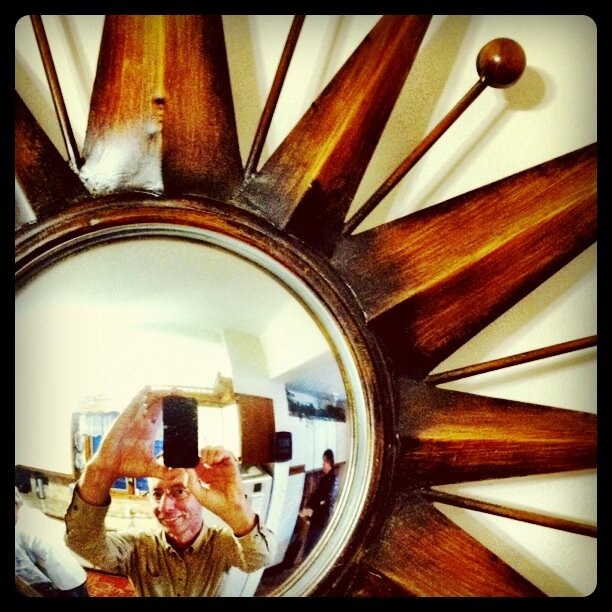 We are closing in on the end of September in South Dakota and that means that fall is here. While there plenty of leaves on the ground, there are also tenacious plans that aren't quite ready to give up.When I saw these leaves, what caught my attention was the subtle backlighting caused by the low western sun. When I pointed my camera at this leaf, I was hoping that I could isolate this one leaf from all the rest. In fact, when I took the photo, I was thinking of using it here with the title "E pluribus unum." But who wants to figure out Latin in a photo blog?
We are closing in on the end of September in South Dakota and that means that fall is here. While there plenty of leaves on the ground, there are also tenacious plans that aren't quite ready to give up.When I saw these leaves, what caught my attention was the subtle backlighting caused by the low western sun. When I pointed my camera at this leaf, I was hoping that I could isolate this one leaf from all the rest. In fact, when I took the photo, I was thinking of using it here with the title "E pluribus unum." But who wants to figure out Latin in a photo blog?
More Old House Geometry
 Almost everything in this photo is geometric and patterned. Even the chipping paint seems patterned.Thanks, by the way for the submissions to the haiku contest. Today is the 5th day after the contest started and thus it will end. I am submitting the many excellent poems to a panel of experts and I will announce the winner in tomorrow's post.
Almost everything in this photo is geometric and patterned. Even the chipping paint seems patterned.Thanks, by the way for the submissions to the haiku contest. Today is the 5th day after the contest started and thus it will end. I am submitting the many excellent poems to a panel of experts and I will announce the winner in tomorrow's post.
Mercurial II
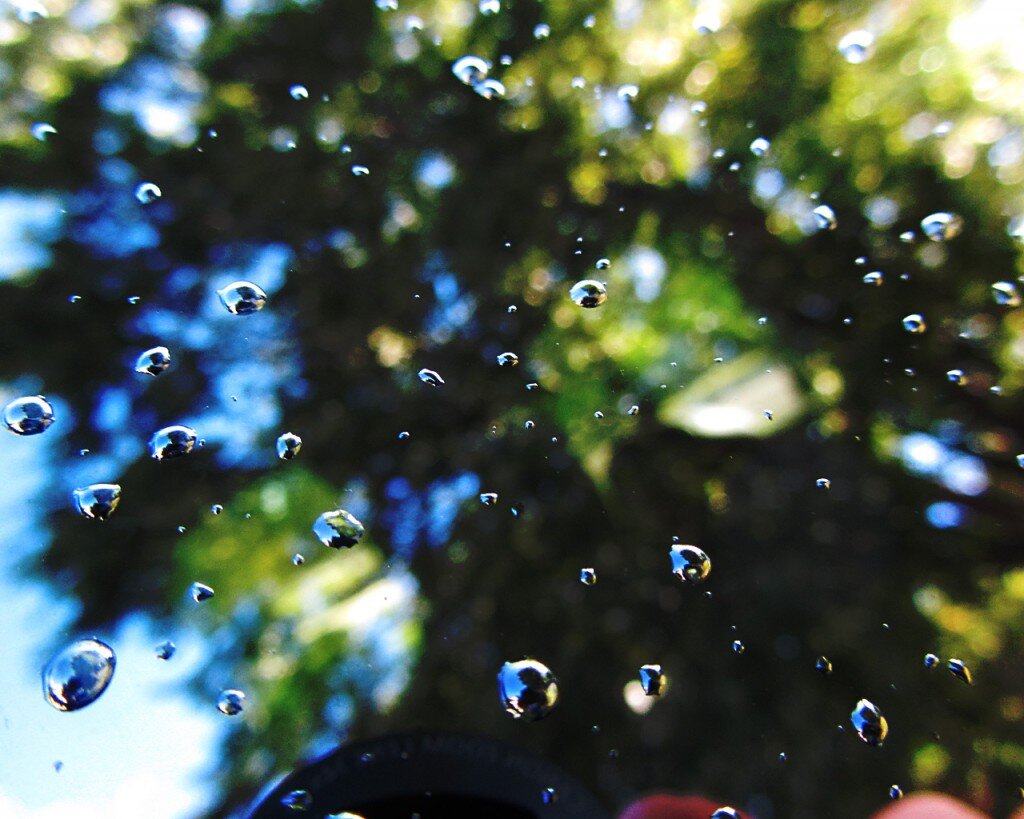 I've compared water drops to mercury before in this blog. But for those who have seen beads of mercury, you'd have to admit that these water drops, photographed from the inside of my pickup's front window, look more like silvery mercury than beads of water.A good photo? You'll make that judgement. A different view of reality? As a photographer, I try to offer that from time to time.Incidentally, this photo was taken with a Canon SX230 HS, a palm-sized point-and-shoot camera. I'm impressed with its ability to blur the background. And provide a little bokeh! Notice, incidentally, that the tree in the background is blurred but that each water drop acts as a lens and offers a somewhat focused view of the same tree.CanonSX230 HS 1/30s f/3.1 ISO640 5mm
I've compared water drops to mercury before in this blog. But for those who have seen beads of mercury, you'd have to admit that these water drops, photographed from the inside of my pickup's front window, look more like silvery mercury than beads of water.A good photo? You'll make that judgement. A different view of reality? As a photographer, I try to offer that from time to time.Incidentally, this photo was taken with a Canon SX230 HS, a palm-sized point-and-shoot camera. I'm impressed with its ability to blur the background. And provide a little bokeh! Notice, incidentally, that the tree in the background is blurred but that each water drop acts as a lens and offers a somewhat focused view of the same tree.CanonSX230 HS 1/30s f/3.1 ISO640 5mm
Geometry
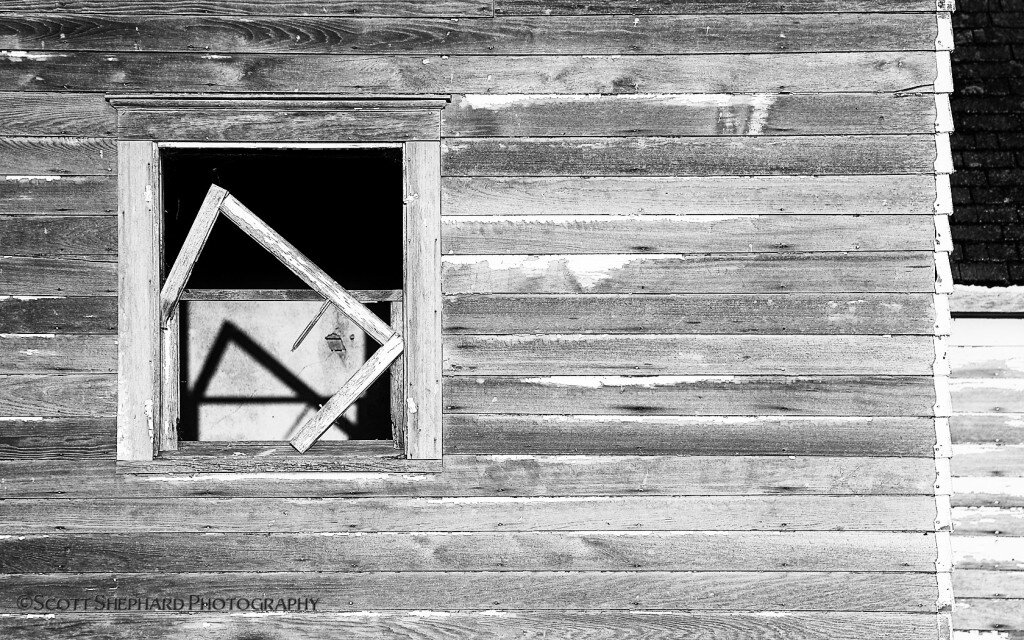 Even the collapsing window frame of an abandoned farm house shows a precise geometric pattern in the strong, morning light.By the way . . . I sometimes wonder if people read my posts. More probably, you aren't into words and you come to my blog to see what I've posted. From my blog stats it is more probable that you've done a Google search and all you want is a photo for your Powerpoint.But for those who read, and who love wordplay, here's a challenge: Look at my picture and turn your reactions to it into a haiku. Then post it as a comment. The prize to the best haiku posted will be a 5x7 mounted print of you favorite "A Photo A Day" blog post sent to your address anywhere in the world. Seriously. Contest ends 1 week from now. By the way a traditional Japanese Haiku has three lines with 17 syllables:First line: 5 syllablesSecond line: 7 syllablesThird line: 5 syllables
Even the collapsing window frame of an abandoned farm house shows a precise geometric pattern in the strong, morning light.By the way . . . I sometimes wonder if people read my posts. More probably, you aren't into words and you come to my blog to see what I've posted. From my blog stats it is more probable that you've done a Google search and all you want is a photo for your Powerpoint.But for those who read, and who love wordplay, here's a challenge: Look at my picture and turn your reactions to it into a haiku. Then post it as a comment. The prize to the best haiku posted will be a 5x7 mounted print of you favorite "A Photo A Day" blog post sent to your address anywhere in the world. Seriously. Contest ends 1 week from now. By the way a traditional Japanese Haiku has three lines with 17 syllables:First line: 5 syllablesSecond line: 7 syllablesThird line: 5 syllables
Morning Light
 Mac would never pose for me, of course. So any interesting photo of him is a bit of an accident. I was actually trying to photograph the shadows of the shuttered light on the far wall of the living room when Mac jumped onto the back of the sofa and blocked the very light I was playing with.At first, I was peeved but then saw the photo opportunity. I took 8 photos but this is the only one where his eyes aren't shaded. I experimented with turning this into a black and white photo because I think there is a little too much color to distract us from the focal point - which is Mac. In the end, I liked the mix of warm and cool colors, including Mac's orangish fur. To lessen the bright color of the sofa, I used Photoshop to create a vignette.And now I like the color. I especially, like the bluish tint on the wooden shades contrasting with Mac's color. And everybody knows that orangish and bluish are complementary colors.For a little insight in to the creative and artistic side of photography, watch my screencast about how I edited this photo: http://www.screencast.com/t/YAJHszOtN
Mac would never pose for me, of course. So any interesting photo of him is a bit of an accident. I was actually trying to photograph the shadows of the shuttered light on the far wall of the living room when Mac jumped onto the back of the sofa and blocked the very light I was playing with.At first, I was peeved but then saw the photo opportunity. I took 8 photos but this is the only one where his eyes aren't shaded. I experimented with turning this into a black and white photo because I think there is a little too much color to distract us from the focal point - which is Mac. In the end, I liked the mix of warm and cool colors, including Mac's orangish fur. To lessen the bright color of the sofa, I used Photoshop to create a vignette.And now I like the color. I especially, like the bluish tint on the wooden shades contrasting with Mac's color. And everybody knows that orangish and bluish are complementary colors.For a little insight in to the creative and artistic side of photography, watch my screencast about how I edited this photo: http://www.screencast.com/t/YAJHszOtN
Breaking Ground
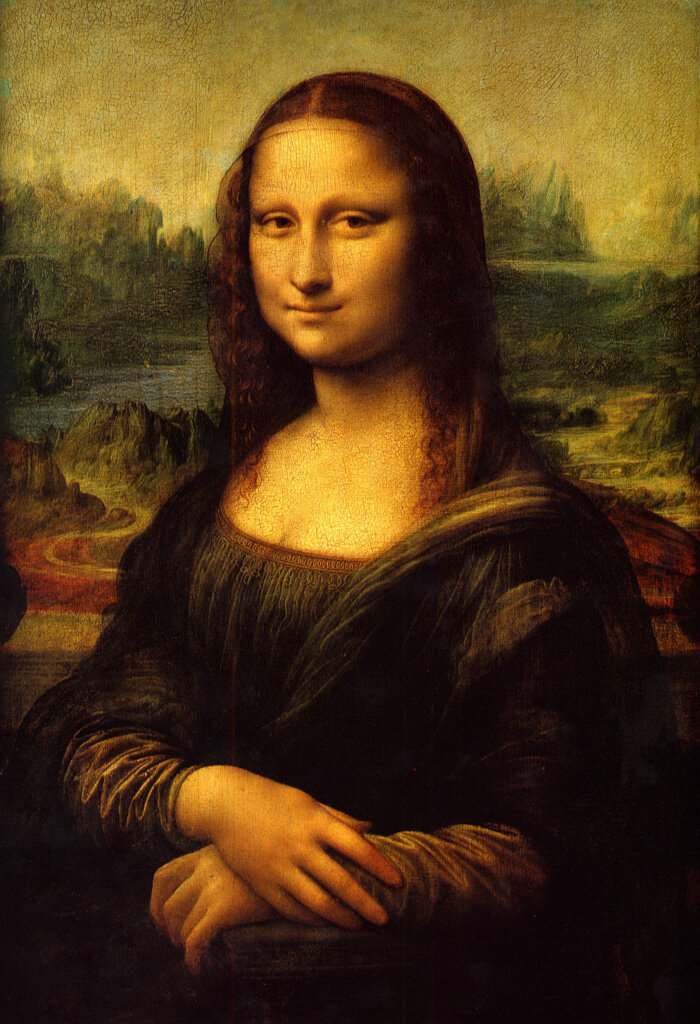 OK, so in a minor way I am breaking ground in this blog because I am A)publishing a painting and B)I am posting someone else's work. Why, you ask?The answer is that I am assigning a "Copy Da Vinci" portrait assignment to my studio photography students and I thought this might also teach you a little about how you might improve your portraits.What Da Vinci did in this painting that helped shape the future of portraiture lies in part in the way the subject is posed. Generally, portraits were full-body and in profile mode before Da Vinci. What Da Vinci did is that he angled Mona Lisa and chose to show us a view of her that focused on her face. Imagine that!Additionally, Mono Lisa is looking right at us and smiling that famous smile. The angle of her shoulders and the gentle position of her hands make Mona Lisa seem relaxed and real. Of course we try to get the same effect in modern portraits.Da Vinci did do one thing that I would tell my photography students not to do and it has to do with the way the hands are posed. These days the general rule that that the back of the hand should never face the camera. What that does is that it presents an element in the photo (due to its size and brightness) that that competes with the face. And a portrait generally is all about the face.Da Vinci gets away with this hand showing because of the neat, nearly triangular shape that defines Mona. And, of course, the face is what clearly dominates this painting.Do you want to take good photos? How about finding some great works of art and copying them. When you start to copy, you start to see techniques and compositional elements that you may not have otherwise seen.
OK, so in a minor way I am breaking ground in this blog because I am A)publishing a painting and B)I am posting someone else's work. Why, you ask?The answer is that I am assigning a "Copy Da Vinci" portrait assignment to my studio photography students and I thought this might also teach you a little about how you might improve your portraits.What Da Vinci did in this painting that helped shape the future of portraiture lies in part in the way the subject is posed. Generally, portraits were full-body and in profile mode before Da Vinci. What Da Vinci did is that he angled Mona Lisa and chose to show us a view of her that focused on her face. Imagine that!Additionally, Mono Lisa is looking right at us and smiling that famous smile. The angle of her shoulders and the gentle position of her hands make Mona Lisa seem relaxed and real. Of course we try to get the same effect in modern portraits.Da Vinci did do one thing that I would tell my photography students not to do and it has to do with the way the hands are posed. These days the general rule that that the back of the hand should never face the camera. What that does is that it presents an element in the photo (due to its size and brightness) that that competes with the face. And a portrait generally is all about the face.Da Vinci gets away with this hand showing because of the neat, nearly triangular shape that defines Mona. And, of course, the face is what clearly dominates this painting.Do you want to take good photos? How about finding some great works of art and copying them. When you start to copy, you start to see techniques and compositional elements that you may not have otherwise seen.
Before the Start
 In the minutes before the start of a sailboat race, things can look a little chaotic. The challenge is to cross the start line (not visible in this photo) after the starting gun goes off, not before. Before the race, then, you might have boats that are going in opposite or seemingly random directions.All of this happened in slow motion on the nearly calm day Deb and I were in Gig Harbor, Washington, a few years ago.The dull, cloudy day is made to look a little brighter due to some Photoshop magic. A tutorial is in the works for those who might be interested in knowing the technique.
In the minutes before the start of a sailboat race, things can look a little chaotic. The challenge is to cross the start line (not visible in this photo) after the starting gun goes off, not before. Before the race, then, you might have boats that are going in opposite or seemingly random directions.All of this happened in slow motion on the nearly calm day Deb and I were in Gig Harbor, Washington, a few years ago.The dull, cloudy day is made to look a little brighter due to some Photoshop magic. A tutorial is in the works for those who might be interested in knowing the technique.
Slowly Going Nowhere
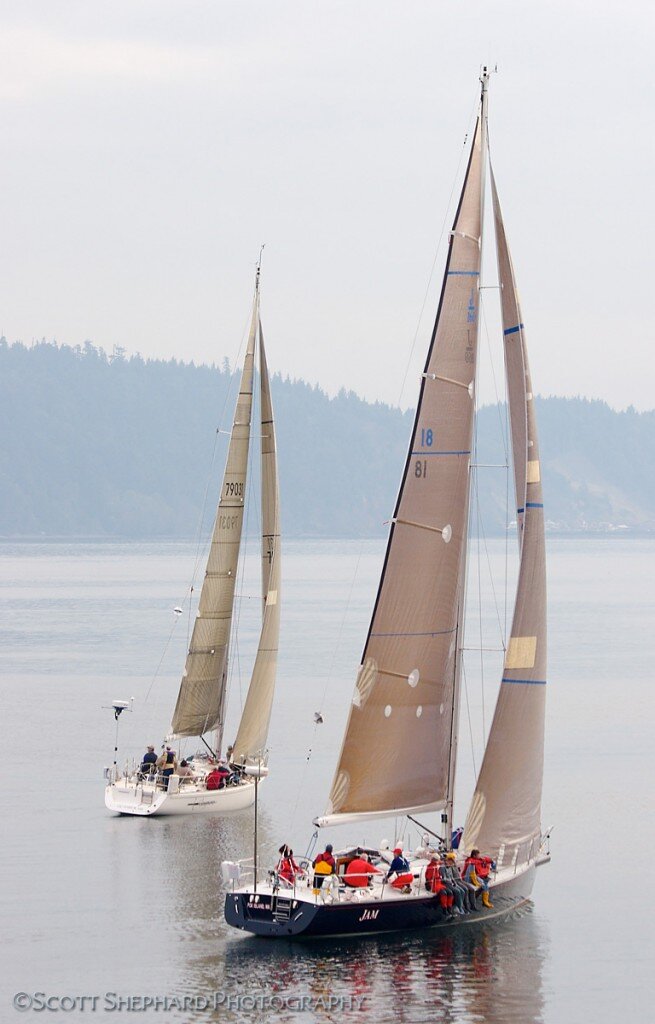 Somebody once said that a good definition of sailing was "slowly going nowhere at great expense." These boats were photographed leaving Gig Harbor in Washington state on a nearly windless day and they were certainly moving at a deliberate pace.Though it was a generally gray (a typical western Washington) day, the boats in this Saturday regatta were still photogenic.
Somebody once said that a good definition of sailing was "slowly going nowhere at great expense." These boats were photographed leaving Gig Harbor in Washington state on a nearly windless day and they were certainly moving at a deliberate pace.Though it was a generally gray (a typical western Washington) day, the boats in this Saturday regatta were still photogenic.
Juxtaposition
 How about something from the 20th century, the 18th century and the 1st century in the same photo? If you travel to places like Segovia, Spain, that's not hard to come by.The Roman aqueduct that dominates that photo is the oldest structure seen here, though it is in amazingly good shape - especially since only gravity holds this structure up. That's right, there's no cement!So the question is: If the aqueduct is made of carefully carved and aligned stacked stone, how do the build the arches? In other words, since the last stone in the arch to go in is the one at the stop (the keystone) how do they keep the other stones in place before placing it?
How about something from the 20th century, the 18th century and the 1st century in the same photo? If you travel to places like Segovia, Spain, that's not hard to come by.The Roman aqueduct that dominates that photo is the oldest structure seen here, though it is in amazingly good shape - especially since only gravity holds this structure up. That's right, there's no cement!So the question is: If the aqueduct is made of carefully carved and aligned stacked stone, how do the build the arches? In other words, since the last stone in the arch to go in is the one at the stop (the keystone) how do they keep the other stones in place before placing it?
Return To La Sagrada Familia
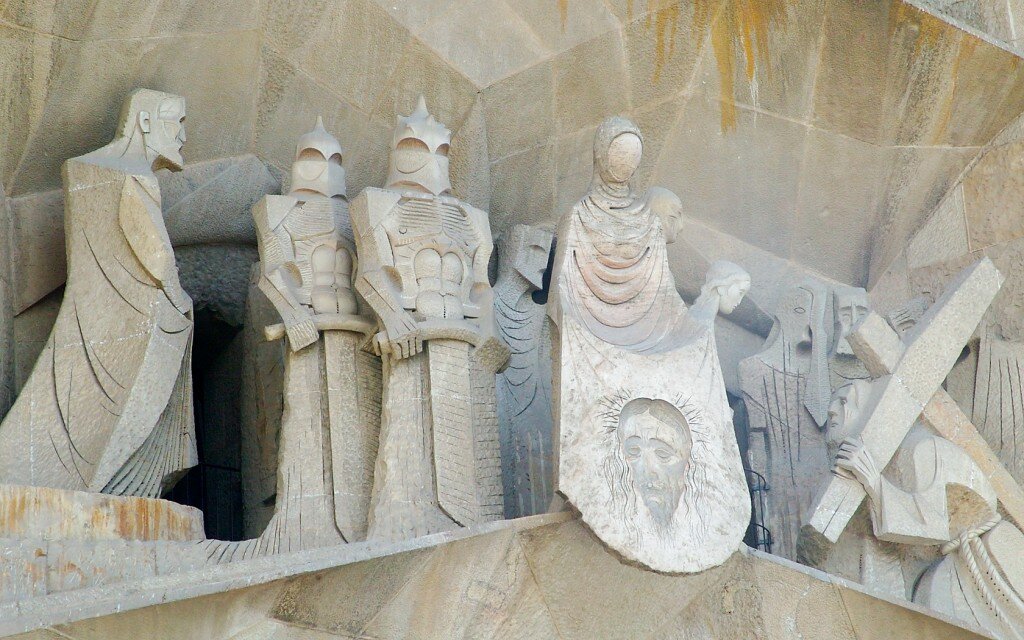 The other day I was changing the desktop on my Mac and I came across this photo, which was featured in a post from almost exactly two years ago. I won't go into the details on this famous Barcelona landmark since the earlier post does that already.The one thing that is striking about the architecture of cathedral is its diversity, which I think was a Gaudi trademark. The square, block-like design of these figures is remarkably different from the kind of detail you see in the earlier post.I would love to go back to Barcelona to see what progress has been made since I was there is 2004. In fact, I'd love to go back to Barcelona for any reason, as it was one of my favorite places in Europe.
The other day I was changing the desktop on my Mac and I came across this photo, which was featured in a post from almost exactly two years ago. I won't go into the details on this famous Barcelona landmark since the earlier post does that already.The one thing that is striking about the architecture of cathedral is its diversity, which I think was a Gaudi trademark. The square, block-like design of these figures is remarkably different from the kind of detail you see in the earlier post.I would love to go back to Barcelona to see what progress has been made since I was there is 2004. In fact, I'd love to go back to Barcelona for any reason, as it was one of my favorite places in Europe.
Arches Gone Wild!
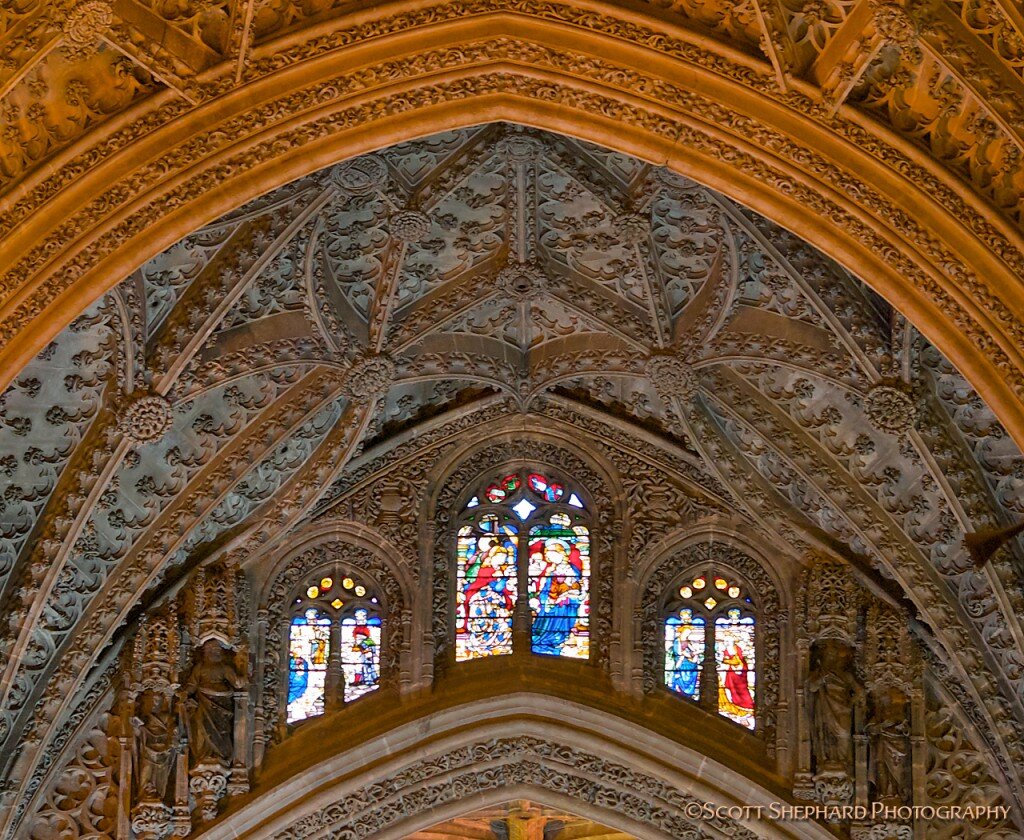 Today's post features a detail photo of some of the stone work in the Cathedral in Seville, Spain. Why "Wild" in the title? As you will see in Monday's post, the Roman arch was round and utilitarian. A thousand years later someone in western Europe decided to enhance the look a little. And the so-called "Gothic" arch was invented. It's main feature is that it is somewhat pointed at the top. The other feature is that medieval stone masons, without the benefit of sophisticated math and computer modeling, were able to make whole ceilings out of arched stone. And while they were at it, the dressed up the stone with elaborate carvings.The carvings add nothing structural to the arch. But they do look nice!
Today's post features a detail photo of some of the stone work in the Cathedral in Seville, Spain. Why "Wild" in the title? As you will see in Monday's post, the Roman arch was round and utilitarian. A thousand years later someone in western Europe decided to enhance the look a little. And the so-called "Gothic" arch was invented. It's main feature is that it is somewhat pointed at the top. The other feature is that medieval stone masons, without the benefit of sophisticated math and computer modeling, were able to make whole ceilings out of arched stone. And while they were at it, the dressed up the stone with elaborate carvings.The carvings add nothing structural to the arch. But they do look nice!

